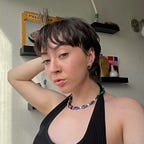Analog 3D Model: Fact-checking tie
A design process blog in the post-truth era
Some say we now live in a post-truth era. Some say we always have. Whichever is true, we can all agree humans lie — and some humans much more than others. Mistruths range from harmless white lies to political misinformation. Recently, we’ve observed the latter on the 2020 Presidential election debate stage. The dialogue between candidates Pres. Donald Trump and former VP Joe Biden in the first debate was full of disagreement, contradiction, and interruption. It was hard to follow along, and even harder to tell fact from fiction. After the debate, watchers could check websites like Politifact to find out for sure. But wouldn’t it be so much easier if the audience could do this in real time?
Design
After ideating with this issue in mind, I came up with an concept: a fact-checking smart tie. The tie would be worn by candidates during debates to provide live fact-checking to the audience. It would upload audio to an external fact-checking program and determine the validity of the candidates’ statements within milliseconds. The tie would then respond to the determination of the program by turning green if the statement is true, red if it’s false, and orange if it’s partially true or partially false. This product wouldn’t necessarily be desirable for political candidates. Instead, I imagine the fact-checking tie would be required for the candidates to wear during debates. Although the physical user of the tie would be the candidate, the audience would benefit most from the product. Although a reliable, instantaneous fact-checking program may not be entirely feasible at this time, this design is an exploratory solution to the issue of political misinformation.
After sketching up my initial concept, I began to think more practically about how I’d make my idea work. Having used Adafruit LED Neopixels in a past e-textile project, I figured they’d do the trick for the color-changing component of the design. Using Neopixel strips would not only bring my concept to life, but also add a stripe pattern to the tie. I also thought more about the mic component of my design. After mulling over options, I decided on a clip mic. Of course, this was still a simplified design and I would have to later consider the electronic specifics (like connecting the LEDs to the mic in a circuit). Developing my concept further helped me move into the prototyping phase with more confidence, yet left enough room for future development.
Prototype
Moving on to the prototyping phase, I searched my apartment and scrounged for materials. For the tie, I found some black linen fabric leftover from a past craft project. Linen wasn’t the ideal fabric to use for the tie, but it was all I had to work with. I drew two outlines onto the fabric with pencil, and sewed them together at the sides to make the proper thickness for the tie. I then chose a white binder clip to prototype the mic component because it was a similar shape and would allow me to attach it to the tie in a similar fashion. To make the clip look more like a mic, I used a sharpie to draw dots on its front side. After clipping it onto the tie, I removed the metal part from the front of the clip, so that it better matched my design. Finally, I painted stripes on the tie with metallic OPI nail polish to resemble the Neopixels. The finished prototype matched the form of my design almost perfectly.
Analysis
After an informal user testing session with my roommate, I was able to gain insight and advice. While trying it on, the clip-on mic proved to be an obstacle for her. Because I had removed the metal part of the binder clip, it was impossible to remove it and created issues while she was tying the tie. Additionally, the linen fabric kept catching. After she finished tying it, we noticed the size of the tie was off. I had not done research on the length of a tie before cutting the fabric, and ended up making it too short. Because of the lack of functional components in the prototype, I wasn’t able to evaluate beyond the tying experience and fit. Although my prototype matched my intended design in form, it lacked in function.
During a critique session with my colleagues, I received further feedback on how I could improve my design. In order to make my prototype more functional, one person suggested that I could have cut out strips from the fabric, then slid in different colored paper strips in order to simulate the color changing component. If I had instead used this technique to prototype, I would have been able to user test the color-changing function of the smart tie.
Another of my colleagues pointed out a flaw in my design as a whole — the tie is not gender inclusive. I was aware of this flaw from the beginning, but hadn’t yet considered alternatives. They suggested simplifying the design to a clip with an LED, similar to the flag pins candidates often wear during the debates. A clip would provide much less visibility than the tie design, but would allow the user to attach it to any type of clothing. If I had instead prototyped this design, I would have conducted user testing to check that the light would be large enough and conspicuous enough to draw adequate attention from the audience.
The informal user testing and the critique session with my colleagues helped me reflect on what I would do differently in another iteration. While prototyping, I paid too much attention to form, and not enough on function. If I had time to redo my process, I would have given more consideration to alternative designs in the beginning, and I would have spent more time planning and picking out functional materials for my prototype.
